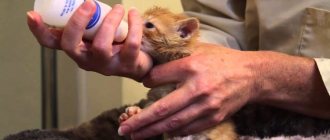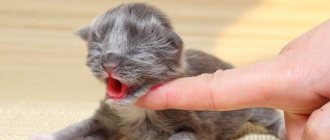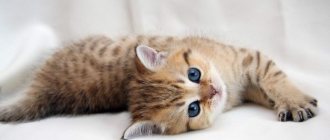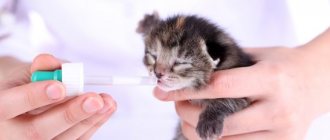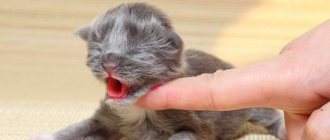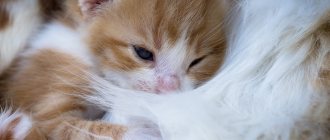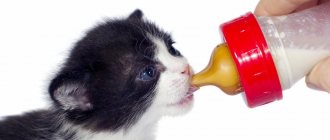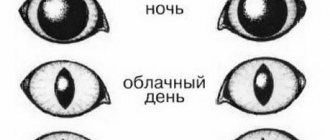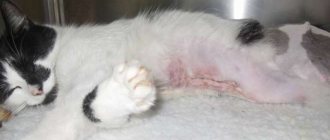Home » Useful Information
- 2 Nurse cat or artificial feeding
- 3 Preparing a place for keeping kittens
- 4 How often to feed kittens
- 5 Cow's milk or formula?
- 6 How to make your own mixtures
- 7 How to properly feed a blind kitten
- 8 How to determine if a kitten is fed enough
- 9 Simple and important care tips
In what cases are newborn blind kittens left without a mother-nurse?
In what cases does the question arise, how to feed newborn kittens without a cat?
Sometimes it happens that a cat dies during childbirth or immediately after it.
It happens that for some reason she refuses to feed her offspring.
And sometimes the soulless owners of their four-legged pet can simply throw the offspring outside so as not to violate their comfort zone.
In any case, orphaned kittens can be saved, even if it is not possible to find a nursing cat and give her sucklings.
A wet nurse is, of course, an ideal option, but such an opportunity is not always available.
Caring for newborn kittens requires patience and some knowledge
The main thing is to properly ensure their maintenance. And this:
- arrangement of a cozy “nest” with heating;
- providing nutrition equivalent to mother's milk;
- proper care for babies, taking into account their physiological needs.
When a newborn kitten may need human help
There are quite a lot of circumstances under which it is impossible for a cat to care for kittens. We list the main ones:
- death of an animal during childbirth;
- complicated birth, after which the cat needs time to recover;
- lack of lactation;
- insufficient milk to feed the entire brood.
In addition to the above, it also happens that a cat may simply refuse to care for her offspring, not allowing the kittens to come near her. In all these cases, the owner must take on the burden of caring for the newborn.
How to determine the age of a kitten
When nursing kittens, it is very important to know exactly their age, because the acceptability of this or that food for them, as well as the feeding regimen and norms, depends on this.
Newborn kittens, which have a small remnant of the umbilical cord on their tummy in the form of a characteristic “tail,” cannot be older than one week. Usually it disappears on its own approximately 3 days after birth, but sometimes this period shifts slightly upward.
A kitten with an umbilical cord cannot be older than 1 week
When conducting an external examination of a kitten, you should pay attention to its eyes. If they are closed, then the baby has not crossed the two-week mark of life. If the eyes are slightly open but remain narrow, then he is about 3 weeks old. They open completely when they are about a month old.
If the kitten's eyes are slightly open, he is 2 to 3 weeks old.
You should also pay attention to your baby's teeth. The first incisors appear in the third week of life. All teeth erupt by 4 months. And after the 5th month they begin to be replaced by radical ones.
The ears can also provide information about the age of the kitten. They are fully expanded by 3 weeks. Newborn babies' ears are completely pressed to their head.
The kitten's ears are completely straightened - the baby is over 3 weeks old
A fairly accurate method of determining the age of a kitten is to weigh it:
- a newborn weighs about 100 grams;
- at the age of 2 weeks the weight will be about 200 grams;
- a month-old kitten weighs 250–300 grams.
Undoubtedly, weight is greatly influenced by the baby’s nutrition and health status, therefore, to obtain a reliable result, it is necessary to evaluate all of the above signs comprehensively.
Do you need veterinarian help?
If the cat refuses to feed the kittens or dies in childbirth, then immediately after their birth it is necessary to call a veterinarian to examine the newborns. The specialist will be able to assess the health of the babies and give recommendations on care and feeding.
If the kittens are developing normally, then there is no need for additional consultations with a veterinarian. However, if the kitten is sick or does not gain the weight required for its age, then the help of a specialist in this case is necessary.
Nurse cat or artificial feeding
When deciding how to feed a newborn kitten without a cat, you need to understand that a wet nurse is the ideal solution for both the smallest kitten and its owner.
As a rule, a nursing cat accepts one or more babies easily.
The main thing is to know that the mother and her kittens are healthy and will not infect the babies with infectious diseases, in particular ear mites .
Important! Colostrum, which a cat feeds its kittens in the first two days, is usually not enough. If your kittens are older than those she is nursing, you will need to continue feeding the babies until the nurse begins to produce enough milk.
Preparing a place for keeping kittens
Under normal conditions, the cat independently provides its babies with the optimal temperature regime.
She warms the little kittens who are with her all the time.
Considering that the physiological norm for a cat’s body temperature is 38 degrees, when arranging a place for babies, it is important to take into account that in the nest it should be a little higher.
An electric or simple heating pad is suitable for heating; an infrared heater is perfect.
You can also use plastic bottles with warm water.
Of course, the water in a simple heating pad or bottle will have to be changed frequently.
But this will not be difficult, because small kittens have to be fed several times a day.
This way it will be easy to control the temperature.
It is best to wrap the bottle in a towel or terry cloth.
It is best to cover the nest with soft, non-synthetic fabric or baby diapers, which, unlike fabric, do not need to be washed.
When choosing between a cardboard box and a basin, it is better to choose a basin: a cardboard box can get wet and absorb odors.
Therefore, keeping small kittens in a basin or plastic box will be more hygienic.
carrying bag is also suitable for this purpose .
Houses for cats will also come in handy , only later: caring for orphaned kittens up to one month of age is not entirely convenient in them.
How often to feed kittens
Month-old kittens can already feed on their own.
But until this time, they will have to pay maximum attention, because they will have to be fed both during the day and at night every two to three hours.
Animals must be handled with extreme caution
The algorithm for feeding small kittens looks like this:
- up to two weeks of age, feeding every two to three hours without a night break;
- in the third and fourth weeks - every two to three hours during the day plus one night feeding;
- from the fifth to the seventh week - every three to four hours during the day, and night feeding is canceled as the babies grow older.
After feeding
After eating, small kittens, like infants, have the habit of burping. Therefore, after the feeding process is completed, before starting the massage, the babies need to be placed on their tummy and gently stroked on the back until they burp.
If the kitten cannot burp, you need to keep its face straight and motionless. If this measure does not produce results, it is worth trying to feed the baby again; perhaps he did not receive his food allowance.
Cow's milk or formula?
Cow's milk is not the best option for a blind kitten, since its composition is significantly different from the composition of cat's milk.
In addition, it can cause allergies in kittens, resulting in redness of the skin and paws.
The ideal solution is dry mixtures, which can be purchased at veterinary pharmacies.
The mixtures have a balanced composition, which contains all the components necessary for the growing body.
Each package of powdered cat milk replacers Katzenmilch, Royal Canin BabyMilk, Gimpet Cat-Milk, Beaphar Kitty-Milk, Hartz contains a special bottle with a nipple.
Bottles with a nipple are very convenient when feeding kittens
Cat milk replacer
There is no natural alternative to cat milk, which is not surprising from the point of view of nature itself. But wise, caring manufacturers have already learned to create mixtures that are safe to replace cat milk. Even if not to the fullest extent, it is better than nothing. The most important thing is that the products contain vital components for the kitten:
- vitamins and minerals;
- amino acids;
- fatty acids (Omega-3 and Omega-6);
- microelements.
There are more than three dozen manufacturers of artificial cat milk in the world, whose products differ in composition, quality and, accordingly, cost. The most famous brands (some of them also produce food):
- Royal Canin;
- Beafar;
- Kamon;
- Nutri-Wet;
- Dolphos;
- Clouders;
- Jimborne;
- Trixie;
- Harts;
- Vo-Toys;
- Jimpet.
Unfortunately, having taken on such a responsible task, many manufacturers have not been able to recreate the formula of cat milk as accurately as possible. They overlooked many ingredients, without which the correct development of the cat could be in jeopardy. But the products “Royal Canin”, “Beafar” and “Gimpet” have established themselves as the most complete mixtures in terms of ingredients. In addition, the three named products replicate the proportion of nutrients contained in real cat milk.
How to make your own mixtures
If it is not possible to buy ready-made mixtures, you can prepare them at home yourself.
The main thing is to follow the recipe.
- “Universal” mixture:
- 20% condensed milk diluted 1:5,
- bone meal (1 tsp per 1 liter of milk).
- Mix “Kitten”
- cow's or goat's milk – 25 g
- glucose 5% (20 ml)
- powdered milk – 5 g
- vitamin supplements - 1g.
- “Vitamin” mixture - recommended for weakened and sick kittens
- milk (100 ml)
- glucose 5% (20 ml)
- 1 yolk
- vegetable oil (1/2 teaspoon)
- Tetravit (about 0.3 ml)
- 2 teaspoons of infant formula “Nutrilon fermented milk”.
- “Egg” mixture:
- cow's milk – 200 ml,
- vegetable oil – 1 tsp. spoon,
- egg yolks – 2 pcs.,
- vitamins in drops (tetravit or trivit).
The ingredients of the mixtures must be mixed thoroughly and brought to a homogeneous mass.
Before feeding, the mixture is heated to 38 degrees.
The finished mixture should be stored in the refrigerator for no more than a day.
How to properly feed a blind kitten
To feed a one-week or two-week-old kitten, you need to purchase a pacifier and bottle from a veterinary pharmacy.
An ordinary medical syringe without a needle will also work.
You can use a rubber tip from a pipette, pierced with a hot needle and placed on a small vial.
It is better to feed a kitten up to one month of age from a nipple
Firstly, the sucking instinct is satisfied, and secondly, the risk of aspiration of the respiratory tract with milk or formula is reduced, which can lead to pneumonia.
Feeding from a pipette or syringe requires great care.
Since babies' immunity is still weak, any infection can be fatal.
Important! Cleanliness and sterility of nipples and bottles is an integral rule that must be strictly followed.
While the cub is eating, it is advisable to stroke its head and back and talk to it quietly.
There is no need to limit milk or formula - the suckling's face should be in milk, and the tummy should be rounded.
After feeding, it is advisable to hold the suckling upright.
When the blind kitten is full, he begins to fall asleep, and milk bubbles appear from his mouth.
He needs to wipe his face with a napkin soaked in warm water.
Many people are interested in whether it is possible to determine how much food the baby has received?
It’s possible - well-fed babies calmly fall asleep, but hungry ones get restless, crawl, and squeak.
If you give them a finger, they start sucking it.
Basic rules for proper feeding of newborns
- The position of babies during feeding is lying on their tummy with their head slightly raised. It is convenient to cover your knees with a soft cloth or towel and sit the kitten/puppy on your legs.
- You should feed only freshly prepared artificial formulas or homemade ones, stored for no more than a day in the refrigerator.
- Be sure to wash your hands with soap before feeding - this will help avoid bacterial stomach upset.
- Any containers used for feeding newborn animals must be boiled for at least 5 minutes. Most often, pipettes, syringes or special bottles and nipples are used, sold in pet stores, veterinary pharmacies or included with breast milk substitutes. Pipettes and syringes should be used with great care, because... Too rapid flow of milk/formula may cause inhalation of food droplets and the development of pneumonia.
- The mixture can be heated in a water bath, or in the microwave. The food temperature should be between 37-38°C in the first 1.5-2 weeks, and then it is brought up to 26°C by the end of the first month of life.
- If a puppy/kitten takes the pacifier and spits it out, it is necessary to open the mouth, lightly pressing on the edges of the jaw, and drop a few drops on the tongue so that the babies feel the taste of the food and understand that they need to suck.
- Bottles/syringes/droppers should be held at approximately a 45° angle.
- Do not press on the container to speed up the feeding process!
- While feeding, stroke the baby's forehead and back - this will stimulate sucking.
- A fed baby lets go of the pacifier and calmly falls asleep, a hungry baby will continue to squeak and look for food.
- After feeding, kittens/puppies must defecate - it is important to monitor this.
- Feeding must be done strictly on time. If babies are sleeping, you should gently wake them up and start feeding them a little at a time.
- Any deviations in the feeding process: refusal of the pacifier, milk coming through the nostrils, restless behavior, unreasonable meowing/whining - this is always a reason to show the babies to the veterinarian and find out what is the reason for this behavior!
How to determine if a kitten is fed enough
Advice! Both overfeeding and underfeeding are dangerous for both a week-old and a two-week-old kitten. We need to find a middle ground. Underfed kittens are lethargic or restless and do not gain weight. When overfeeding, problems with stool appear.
The main indicator of overfeeding is stool
If it is liquid and yellowish in color, this means that there is slight overfeeding.
With moderate overfeeding, the stool takes on shades of green.
Constant overfeeding is the cause of gray stools.
If the stool turns white, a veterinarian should be consulted to rule out infection.
Vitamins and supplements
From birth until weaning, kittens receive all beneficial substances from the cat through milk and colostrum. But since the animals are artificially fed, their diet must include vitamins and supplements. What complexes are best to give to kittens, be sure to ask your veterinarian.
For two-week-old kittens you can use:
- Glucose (1-2 g per feeding). Promotes weight gain and better satiety.
- Trivit, Tetravit. One drop per serving is enough.
- Gamavit. Immunostimulant. 1 drop per feeding.
- Meat and bone meal. Contains calcium, which is necessary to strengthen bones and teeth.
- Fish fat. Source of vitamin D. Give once every 7-8 days, one drop per feeding.
You can also use vitamins A, D, E, and preparations containing vitamin B (B1, B2, B6, B9, B12).
Note that many vitamin and mineral supplements and preparations are intended for two-month-old kittens and older animals. Therefore, do not overdo it with the dosage.
Keep in mind that industrial milk substitutes already contain minerals and vitamins. An excess, as well as a deficiency of nutrients, can cause health problems.
